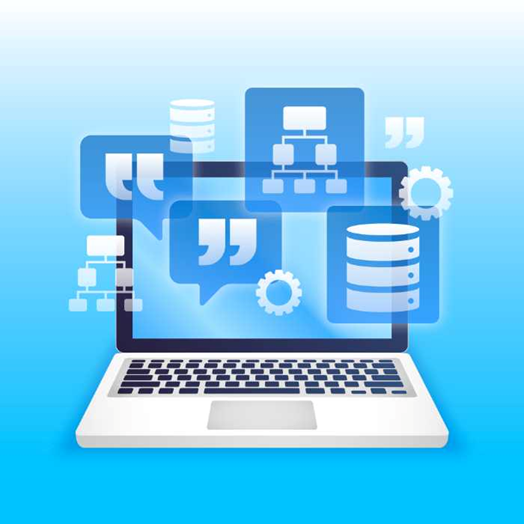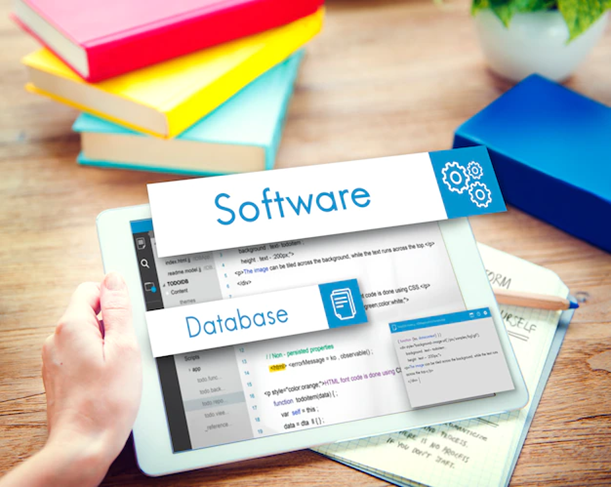Database Management Software: Features, Types, and Uses
Database management system(DBMS):
A database management system (DBMS) is a computer program software that interacts with the user, other applications, and the database itself to capture and analyze data. A DBMS generally manipulates the data itself, the data format, field names, record structure, and file structure. It also defines rules to validate and manipulate this data.

Types of DBMS:
There are many database software available in the market, with different features and functionalities. However, most of them can be classified into two main categories: relational database management systems (RDBMS) and non-relational database management system (NoSQL).
Relational database management system (RDBMS):
RDBMS is the most common type of database software. They are based on the relational model, which organizes data into tables (similar to a spreadsheet). Each table has rows (records) and columns (fields), and each field stores a specific piece of information. Tables can be linked together by common fields (keys), allowing for complex queries and data analysis.
RDBMS are very powerful and can handle large amounts of data. However, they can be complex to set up and use and may require expensive hardware.
Types of RDBMS:
Oracle:
Oracle is a powerful, enterprise-level database management system. It is used by large organizations to store and manage data.
MySQL:
MySQL is a popular open-source database management system. It is used by small and medium-sized organizations to store and manage data.
Microsoft SQL Server:
Microsoft SQL Server is a database management system designed for Windows. It is used by small and medium-sized organizations to store and manage data.
PostgreSQL:
PostgreSQL is a database management system designed for Linux. It is used by small and medium-sized organizations to store and manage data.
Non-relational database management system (NoSQL):
NoSQL databases are less common than RDBMS, but they are growing in popularity, particularly for web-based applications. NoSQL databases are usually simpler to set up and use than RDBMS, and they can scale more easily to meet the needs of large websites or big data applications.
There are many different types of NoSQL databases, each with its own strengths and weaknesses. Some of the most popular include MongoDB, Cassandra, and HBase.
MongoDB:
MongoDB is a popular open-source NoSQL database. It is used by large organizations to store and manage data.
Cassandra:
Cassandra is a powerful NoSQL database designed for high availability. It is used by large organizations to store and manage data.
HBase:
HBase is a NoSQL database designed for big data applications. It is used by large organizations to store and manage data.
NoSQL databases are not a good choice for every application. They may be less reliable than RDBMS and can be more difficult to query and analyze.
Uses of DBMS:
Database management software can be used for a variety of purposes, including storing, organizing, and analyzing data. Common uses include:
- Data warehousing: Database management systems are often used to store data from multiple sources for analysis and reporting.
- Online transaction processing (OLTP): OLTP applications require a database that can handle high volumes of reads and writes. RDBMS are typically used for OLTP applications.
- Business intelligence: Business intelligence applications often require the ability to query large amounts of data quickly. RDBMS are often used for business intelligence applications.
- Web applications: Many web applications use database management systems to store data such as user information, product catalogs, and blog posts. NoSQL databases are often used for web applications.
- Allows users to create, update, and delete databases
- Allows administrators to set up security and access control
- Provides a graphical user interface (GUI) for easy database management
- Offers built-in reporting and analysis tools
- Supports data import/export for easy data migration
- Integrates with other software applications for seamless data management
- Enables real-time data backup and disaster recovery
- Scales easily support large databases and high traffic loads.
- Creating, updating, and deleting databases
- Setting up security and access control
- Providing a graphical user interface (GUI) for easy database management
- Offers built-in reporting and analysis tools
- Supporting data import/export for easy data migration
- Integrates with other software applications for seamless data management
- Enabling real-time data backup and disaster recovery
Features of DBMS:
There are many database management software available in the market, each with different features and functionalities. However, most of them share some common features, which include:
Conclusion
Database management software is a powerful tool that can be used for a variety of purposes, including storing, organizing, and analyzing data. There are many different types of database management software available in the market, each with its own unique features and functionalities. When choosing a database management system, it is important to consider the specific needs of your organization and the type of data you need to store.

If you are looking for database management software for your organization, please contact Access Database Development. We would be happy to discuss your specific needs and recommend the best solution for your business.
